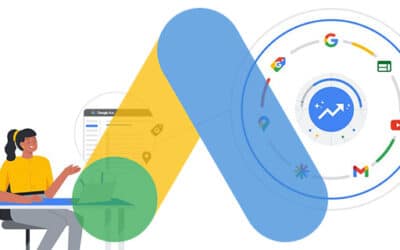As businesses strive to achieve their desired growth in Canada, it’s essential to explore all potential marketing channels. Google Ads, formerly known as Google AdWords, can be a powerful tool to help advance your business goals. With targeted strategies and valuable insights, you can improve your return on investment (ROI) and drive growth.
Key Takeaways:
- Google Ads can be a powerful tool to help businesses advance their goals in Canada.
- Targeted strategies and valuable insights can improve ROI and drive growth.
- Effective keyword research, compelling ad copy, and landing page optimization are crucial for success.
Setting Clear Business Goals
Before we begin utilizing Google Ads to advance our business goals, it is essential to establish clear and specific objectives. By having a clear understanding of what we want to achieve, we can tailor our Google Ads campaigns to meet those objectives.
When setting our business goals, we should focus on both short-term and long-term objectives. Short-term goals should include increasing sales, generating leads, and expanding brand awareness. On the other hand, long-term goals can be centered around building customer loyalty, establishing industry leadership, or expanding into new markets.

#1 Mistake Business Owners Make When Setting Goals
In a fast-paced business environment, setting clear and actionable goals is crucial. Goals guide decision-making, allocate resources, and provide direction to teams. However, simply stating a goal often isn’t enough. It’s vital to ensure that each goal is well-defined and achievable. This is where the S.M.A.R.T. goal-setting framework comes into play.
- Specific: A vague goal like “Increase sales” doesn’t provide direction. By contrast, a specific goal such as “Increase online sales of product X by 15% in Q4” gives teams a clear objective to work towards. Specificity eliminates ambiguity, ensuring everyone understands the exact target.
- Measurable: A goal without a measurable outcome is like a sports game without a scoreboard. How would you know if you’ve achieved it? Measurable goals allow businesses to track progress, make adjustments as needed, and celebrate when targets are met.
- Achievable: It’s essential to strike a balance between ambition and realism. Setting goals that are too easy can lead to complacency. Conversely, unrealistic goals can demotivate teams when they consistently fall short. Achievable goals push teams while still remaining within the realm of possibility.
- Relevant: Each goal a business sets should align with its broader mission and objectives. For instance, if a company’s main objective is brand awareness, a goal focused solely on immediate sales might not be as relevant. Ensuring relevancy helps in prioritizing tasks and initiatives that drive the company forward in its intended direction.
- Time-bound: Deadlines create urgency. Without a clear timeframe, goals can drift, and momentum may be lost. By setting a specific date or time period for achievement, businesses can maintain focus and drive toward their objectives with purpose.
After establishing our goals, we should work towards identifying measurable and attainable key performance indicators (KPIs) that can help track progress towards our desired outcomes. Some of the KPIs that we can keep in mind while setting our business goals include:
| KPI | Description |
|---|---|
| Conversion Rate | The percentage of website visitors who took the desired action, such as making a purchase or filling out a contact form. |
| Cost-per-click (CPC) | The amount of money we pay for each click on our Google Ads. |
| Return on investment (ROI) | The ratio of the profit generated by our Google Ads campaign to the cost of running it. |
By setting clear and measurable KPIs, we can monitor and optimize our Google Ads campaigns regularly to ensure that they are aligned with our business objectives and driving growth.
Next, we will explore how to conduct thorough keyword research to identify relevant and high-performing keywords to target in our Google Ads campaigns.
Powerful Keyword Research and Targeting
Effective keyword research is essential to maximize the impact of your Google Ads campaign. By conducting thorough research, you can discover the keywords your target audience is searching for and create ads that speak directly to their needs and interests. Keyword research helps you:
- Identify the most relevant and profitable keywords for your business
- Understand the language and terminology your target audience uses
- Discover new trends and opportunities in your industry
To conduct keyword research, we recommend using Google’s Keyword Planner tool. This free resource provides search volume and competition data for specific keywords, allowing you to choose the most appropriate terms for your campaign. Additionally, consider using keyword research tools from third-party providers, such as SEMrush, Ahrefs, and Moz.
Targeting
Once you have identified your keywords, it’s essential to target your ads to the right audience. Targeting helps you reach the people who are most likely to convert, saving you money and increasing your return on investment (ROI). There are several targeting options available for Google Ads campaigns:
| Targeting Option | Description |
|---|---|
| Location | Target users in specific cities, regions, or countries |
| Language | Target users who speak a specific language |
| Demographics | Target users based on age, gender, or household income |
| Devices | Target users based on the type of device they are using |
| Keywords | Target users searching for specific keywords related to your business |
It’s essential to choose targeting options based on your business goals and target audience. By creating targeted ads, you can increase your click-through rate (CTR) and improve your chances of converting users into customers.
“Effective keyword research and targeting are the foundation of successful Google Ads campaigns. By understanding your target audience and tailoring your ads to their needs, you can maximize your ROI and drive growth for your business.”
Crafting Compelling Ad Copy
Creating effective ad copy is key to getting potential customers to click on your Google Ads. Your ad copy should be concise, persuasive, and relevant to the search queries and keywords you’re targeting. Remember, you only have a limited amount of space to capture your audience’s attention, so make every word count.
Here are some tips to help you craft compelling ad copy:
- Highlight your unique selling points: Showcase what sets your business apart from competitors. Do you offer a money-back guarantee? Free shipping? Highlight these benefits to make your ad stand out.
- Use action-oriented language: Encourage potential customers to take action by using powerful verbs such as “buy,” “shop,” or “subscribe.”
- Speak to your target audience: Use language that will resonate with your intended audience. If you’re targeting professionals, consider using industry-specific jargon and buzzwords.
- Test and refine your ad copy: Continuously test different variations of your ad copy to see what resonates best with your audience. Make data-driven decisions when refining your ad copy to improve ad performance.
By following these tips, you can create ad copy that will increase the likelihood of potential customers clicking on your ads and ultimately lead to increased conversions.
Maximizing Conversion with Landing Page Optimization
Driving traffic to your website is just the beginning of a successful Google Ads campaign. To achieve your desired growth, it’s crucial to focus on maximizing conversions. That’s where landing page optimization comes in.
Your landing page is where potential customers arrive after clicking on your ad. It’s essential to create a seamless user experience that aligns with your ad copy and encourages visitors to take action. Here are some tips to help you optimize your landing pages:
| Tip | Description |
|---|---|
| 1. | Tailor your landing page to your ad copy: Ensure that your landing page aligns with the messaging of your Google Ad. Use the same language, headlines, and visuals to maintain consistency and reduce bounce rates. |
| 2. | Include a clear Call-to-Action (CTA): Your landing page should have a clear CTA that tells visitors what to do next. Whether it’s filling out a form or making a purchase, make it easy and intuitive to take action. |
| 3. | Optimize your page loading speed: A slow loading page can significantly impact your bounce rates and conversion rates. Optimize your page’s loading speed by compressing images, minimizing HTTP requests and utilizing browser caching. |
| 4. | Provide valuable information: Ensure that your landing pages provide in-depth information about your products or services. This will help establish credibility and build trust with potential customers. |
| 5. | Make it mobile-friendly: With over half of internet traffic coming from mobile devices, it’s essential to ensure that your landing pages are optimized for mobile. Use a responsive design that adjusts to different screen sizes and ensure that your CTAs are easily clickable on mobile. |
By implementing these landing page optimization techniques, you can improve your conversion rates and maximize your Google Ads ROI. Remember to continually monitor and analyze your landing pages and make necessary adjustments to improve your results. With a well-optimized landing page, you can take your business to new heights.
Starting Your Google Ads Account
In conclusion, utilizing Google Ads can be a powerful tool for Canadian businesses to achieve their growth objectives. By setting clear business goals, conducting powerful keyword research, crafting compelling ad copy, and maximizing conversions through landing page optimization, your business can unlock success and drive growth.
As a professional copywriting journalist, we recommend staying proactive by monitoring and analyzing your Google Ads campaigns to make necessary adjustments and continually improving your results.
Start Your Google Ads Journey Today
At the end of the day, Google Ads can help your business expand its reach, increase brand awareness, and drive revenue. Leverage the potential of Google Ads and take your business to new heights of success. Contact us for personalized strategies and insights to advance your business goals with Google Ads.
FAQ
How can Google Ads help businesses advance their goals?
Google Ads can help businesses advance their goals by providing targeted strategies and valuable insights to improve ROI and drive growth. It allows businesses to reach their target audience effectively and tailor their campaigns to meet specific objectives.
Why is it crucial to establish clear business goals before using Google Ads?
Setting clear business goals is crucial before using Google Ads because it helps businesses determine what they want to achieve, whether it’s increasing sales, expanding brand awareness, or generating leads. Having specific goals enables businesses to create effective campaigns tailored to their objectives.
How can effective keyword research and targeting enhance Google Ads campaigns?
Effective keyword research and targeting are essential for successful Google Ads campaigns. Through thorough research, businesses can identify relevant keywords that align with their goals and target audience. This ensures that the campaigns reach the right people at the right time, improving their chances of success.
What role does compelling ad copy play in Google Ads?
Compelling ad copy plays a crucial role in Google Ads as it captures the attention of potential customers. By creating concise, persuasive, and relevant ad copy, businesses can highlight their unique selling points and encourage users to click on their ads, increasing their chances of conversions.
Why is landing page optimization important for maximizing conversions?
Landing page optimization is crucial for maximizing conversions because it ensures a seamless user experience. By aligning the landing pages with the ad copy, providing clear call-to-action, and valuable information, businesses can boost their conversion rates and maximize the ROI of their Google Ads campaigns.
How can businesses leverage Google Ads to achieve growth?
To achieve growth through Google Ads, businesses should set clear objectives, conduct thorough keyword research, craft compelling ad copy, and optimize their landing pages. By continually monitoring and analyzing campaigns, making necessary adjustments, and leveraging the potential of Google Ads, businesses can unlock success and take their growth to new heights.






